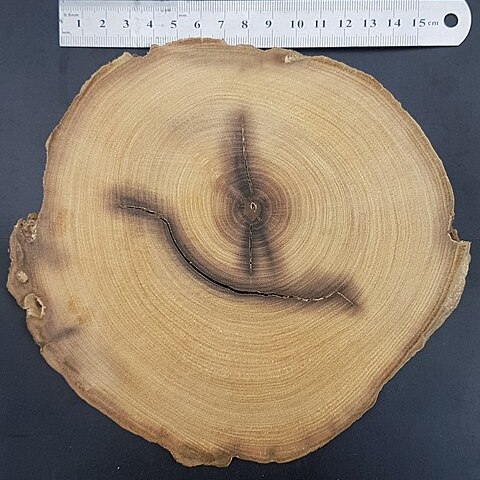Dioecious shrubs or trees, 1-8 m high. Leaves aromatic, alternate, large, oblanceolate, elliptic to narrowly elliptic, rarely obovate, (32-)40-140 x 10-45 mm, discolorous, upper surface bright or dark green, hairy when young, becoming glabrous, reticulate, with glands on margins of reticulations, main vein sunken and hairy, especially in lower half, lower surface densely white-hairy, main and secondary veins conspicuous; apex obtuse to acute, sometimes with curved mucro subapically; base cuneate; margin very often faintly denticulate in upper part, rarely entire. Petiole 5-8(-12) mm long. Synflorescences terminal, paniculate. Male plants: capitula homogamous discoid, 5-10 mm diam., 13-47-flowered; peduncle 2-12 mm long. Involucral bracts densely hairy, fused halfway, 5-lobed; tube 1.5-3.0 mm long; lobes 1.5-2.0 mm long; sometimes with few free, inner bracts. Corolla infundibuliform, glandular and hairy; tube 2.0-3.5 mm long; lobes 5, 1.0-1.5 mm long, papillate, recurved. Anthers 1.0-1.5 mm, exserted, with ovate-triangular, apical appendage, calcarate, caudate, tails ± 0.5 mm long, branched; filaments 1.5-3.0 mm long. Style well exserted, 5-8 mm long, undivided or with 2 small lobes, papillate. Ovary rod-like, 0.5-1.0 mm long, glandular, sterile, septate-hairy. Female plants: capitula homogamous discoid, ± 5 mm diam., mostly 3(-6)-flowered; peduncle 0-4 mm long. Involucral bracts free, 3-6 mm long, in 2 or 3 rows; outer bracts ovate or narrowly lanceolate-ovate, acute; inner elliptic. Corolla infundibuliform, glandular and hairy; tube 1.5-2.0 mm long; lobes 5(6), 0.5-1.0 mm long, papillate, recurved. Style exserted, 2.5-3.5 mm long, with 2 short branches, ± 1 mm long. Ovary elliptic to obovate, 2.5-4.0 mm long, densely septate-hairy and glandular. Cypsela obovate to elliptic, ribbed, 3-5 mm long, densely, white, septate-hairy and glandular. Pappus absent. Flowering time: December to July with a peak from February to March (July) (late summer).
More
Tree or shrub, 1-8 m high. Leaves alternate, large, oblanceolate, elliptic to narrowly elliptic, rarely obovate, discolorous, upper surface bright or dark green, glabrous, lower surface densely white-hairy, base cuneate, apex obtuse to acute, margins often faintly denticulate in upper part, rarely totally entire, distinctly petiolate. Capitula discoid, terminal, paniculate, pedunculate; involucral bracts in a single row in male florets, fused halfway, in 2 or 3 rows in female florets, free. Florets male and female florets on different plants, dark, brownish. Flowering time Jan.-July. Pappus absent. Cypselae obovate to elliptic, ribbed, densely long, white-hairy.
Dioecious, grey-felted shrub or small tree to 5 m, strongly scented of camphor. Leaves elliptic, dull green above. Flower heads discoid, in large panicles, cream-coloured. Achenes woolly.


